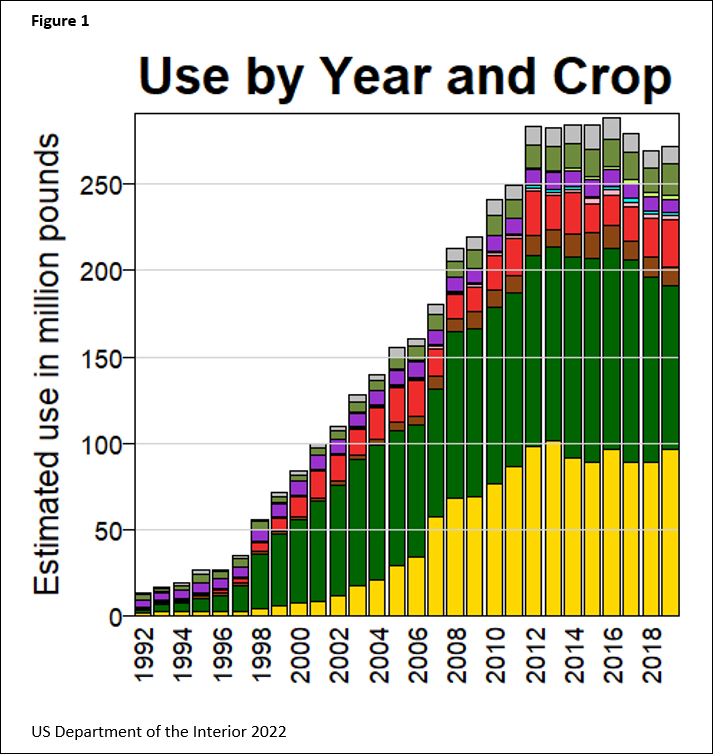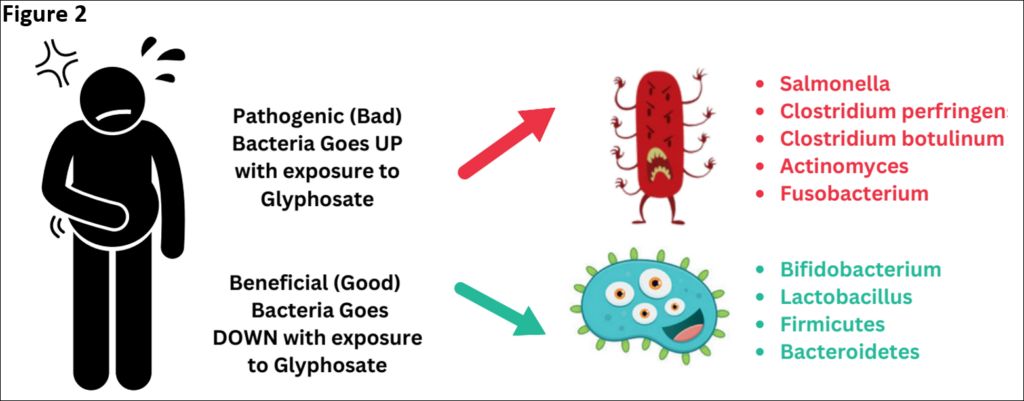Assessing your Exposure to Glyphosate
We are extremely excited about our new Glyphosate Exposure Analysis Test. Today I’ll be talking about what glyphosate is, how it can affect your health, and how to potentially deal with it.
Glyphosate is the main active ingredient for many broad-spectrum herbicides. The use of glyphosate has increased over 25-fold in the last 30 years (Figure 1, US Department of the Interior). Along with the increase of pesticide usage, the US EPA has raised the admissible glyphosate level in soy seeds from 2 ppm to 40 ppm 1. This has led to an increased detection of glyphosate and its by-product, aminomethylphosphoic acid (AMPA) in soil and water 2. There are over 750 different herbicides that contain glyphosate, which has made it difficult to avoid using products that contain it 3. Fresh fruits and vegetables and processed products have been shown to have up to 85 ppb 4.

Human exposure to glyphosate is mainly through food. Glyphosate has been detected in human blood, urine, umbilical cord blood, and breast milk5-7. The US National Nutrition Examination Survey found the herbicide in 80% of urine samples. However, the amount present varies widely8 . One of my favorite toxicology quotes is “the dose makes the poison,” which means almost anything can be toxic if in taken in large enough amounts. The problem with glyphosate is that we do not have enough data to know what safe amounts are. There is evidence that exposure to glyphosate is not harmful in the short term. Still, more long-term exposure research needs to be done because evidence of issues correlated with long-term exposure has been increasing. The health effects attributed to exposure to glyphosate include gut issues, endocrine issues, and elevated levels of glyphosate could increase your risk of cancer 9-11 12.
One of the most common issues that have been reported with glyphosate exposure the effect on the intestinal microbiome. Glyphosate crosses the intestinal-epithelial barrier, and is then excreted in feces and urine13. Common concentrations have been shown to be between 0.16 to 7.6 ppb14. These concentrations have been shown to disrupt the balance of gut microbiota, which in mice leads to anxiety and depression-like behaviors 11,15. This is because of Glyphosate’s designed ability to inhibit the shikimic acid pathway, which is necessary in beneficial bacteria, but not needed in many pathogenic microorganisms11. This leads to the increase of harmful bacteria in the gut and a decrease of beneficial bacteria such as Lactobacillus and Bifidobacterium (Figure 2) 16.

Glyphosate’s interaction with the human endocrine system has been a new avenue of research for many labs. There are some conflicting results in this area, but I want to highlight this possibility and I will update when new research helps settle this debate. One avenue that is being researched is whether glyphosate can activate hormonal activity. Some labs found that glyphosate at relevant concentrations activated estrogen responsive elements (ERE). These papers also found that glyphosate had a weak interaction with estrogen receptor a 17,18. However, another lab reported no such interactions 19. These different results may be caused by the use of different cell lines. The interactions were done in a human breast cancer cell line, where the lack of interaction was done with Chinese Hamster Ovaries (CHO) cells. Other studies have found that glyphosate exposure correlated with reduced progesterone and estrogen production, enhanced uterine sensitivity to estradiol, and shortened pregnancy 20-22. These are interesting findings and could have extremely detrimental effects on pregnant individuals. Future studies are indeed warranted.
Glyphosate and cancer have been showing up in the news more and more. Some of the big headlines have multi-million-dollar damages awarded to several California residents. According to Forbes, Monsanto has settled over 100,000 lawsuits and paying out over $11 billion as of May 2022. Studies have identified an increase risk of developing cancer when exposed to glyphosate. One meta-analysis found that exposure to glyphosate led to an increased risk of forming Non-Hodgkin Lymphoma 12. One cause is the correlation between glyphosate exposure and epigenetic changes of the DNA. Epigenetic modifications are small molecule additions that help the body to know which genes to read and which genes should be silenced in certain cells. Several labs are reporting that patients exposed to glyphosate have changes in their DNA modification, which could change what genes are turned on or off 23. One of the changes that have been observed are the changes in methylation in organisms exposed to glyphosate 24,25. The mechanisms behind these changes are still being investigated, but, if true, could be problematic and difficult to repair.
The final question that individuals will ask is, “How do we remove glyphosate from the body?” The answer is more difficult because there is not much published research on this. The most important aspect of this will be avoidance. After that it becomes more trickier and unknown because glyphosate is not metabolized in the body. Unlike mycotoxins and most medications, glyphosate leaves the body in the same molecular structure that it was when ingested. Glyphosate is very water soluble so increasing the intake of uncontaminated water may help to flush out the toxin. In response to questions about supplements that claim to bind and remove the toxins, I have not seen any research that supports these claims. I would be happy to be informed on the efficacy of some treatment, but the research needs to be there for me to support it.
Thanks for reading. I hope people find this blog informative. I am happy that we have started to test for glyphosate so people have more information about their bodies and take informed health decisions.
For more information on our Glyphosate Exposure Analysis, visit our website.
The views in this blog are those of Dr. Pratt-Hyatt and not necessarily the views of RealTime Labs.
References
- Bukowska, B., Wozniak, E., Sicinska, P., Mokra, K., and Michalowicz, J. (2022). Glyphosate disturbs various epigenetic processes in vitro and in vivo – A mini review. Sci Total Environ 851, 158259. 10.1016/j.scitotenv.2022.158259.
2. Puigbo, P., Leino, L.I., Rainio, M.J., Saikkonen, K., Saloniemi, I., and Helander, M. (2022). Does Glyphosate Affect the Human Microbiota? Life (Basel) 12. 10.3390/life12050707.
3. Nagy, K., Tessema, R.A., Budnik, L.T., and Adam, B. (2019). Comparative cyto- and genotoxicity assessment of glyphosate and glyphosate-based herbicides in human peripheral white blood cells. Environ Res 179, 108851. 10.1016/j.envres.2019.108851.
4. Kolakowski, B.M., Miller, L., Murray, A., Leclair, A., Bietlot, H., and van de Riet, J.M. (2020). Analysis of Glyphosate Residues in Foods from the Canadian Retail Markets between 2015 and 2017. J Agric Food Chem 68, 5201-5211. 10.1021/acs.jafc.9b07819.
5. Steinborn, A., Alder, L., Michalski, B., Zomer, P., Bendig, P., Martinez, S.A., Mol, H.G., Class, T.J., and Pinheiro, N.C. (2016). Determination of Glyphosate Levels in Breast Milk Samples from Germany by LC-MS/MS and GC-MS/MS. J Agric Food Chem 64, 1414-1421. 10.1021/acs.jafc.5b05852.
6. Ferreira, C., Duarte, S.C., Costa, E., Pereira, A., Silva, L.J.G., Almeida, A., Lino, C., and Pena, A. (2021). Urine biomonitoring of glyphosate in children: Exposure and risk assessment. Environ Res 198, 111294. 10.1016/j.envres.2021.111294.
7. Cellier, M., Anthony, N., Bruneau, C., and Descatha, A. (2022). Determination of Glyphosate and AMPA in Blood Can Predict the Severity of Acute Glyphosate Herbicide Poisoning. Lab Med 53, 394-398. 10.1093/labmed/lmac002.
8. Ospina, M., Schutze, A., Morales-Agudelo, P., Vidal, M., Wong, L.Y., and Calafat, A.M. (2022). Exposure to glyphosate in the United States: Data from the 2013-2014 National Health and Nutrition Examination Survey. Environ Int 170, 107620. 10.1016/j.envint.2022.107620.
9. Marino, M., Mele, E., Viggiano, A., Nori, S.L., Meccariello, R., and Santoro, A. (2021). Pleiotropic Outcomes of Glyphosate Exposure: From Organ Damage to Effects on Inflammation, Cancer, Reproduction and Development. Int J Mol Sci 22. 10.3390/ijms222212606.
10. Maddalon, A., Galbiati, V., Colosio, C., Mandic-Rajcevic, S., and Corsini, E. (2021). Glyphosate-based herbicides: Evidence of immune-endocrine alteration. Toxicology 459, 152851. 10.1016/j.tox.2021.152851.
11. Rueda-Ruzafa, L., Cruz, F., Roman, P., and Cardona, D. (2019). Gut microbiota and neurological effects of glyphosate. Neurotoxicology 75, 1-8. 10.1016/j.neuro.2019.08.006.
12. Zhang, L., Rana, I., Shaffer, R.M., Taioli, E., and Sheppard, L. (2019). Exposure to glyphosate-based herbicides and risk for non-Hodgkin lymphoma: A meta-analysis and supporting evidence. Mutat Res Rev Mutat Res 781, 186-206. 10.1016/j.mrrev.2019.02.001.
13. Brewster, D.W., Warren, J., and Hopkins, W.E., 2nd (1991). Metabolism of glyphosate in Sprague-Dawley rats: tissue distribution, identification, and quantitation of glyphosate-derived materials following a single oral dose. Fundam Appl Toxicol 17, 43-51. 10.1016/0272-0590(91)90237-x.
14. Gillezeau, C., van Gerwen, M., Shaffer, R.M., Rana, I., Zhang, L., Sheppard, L., and Taioli, E. (2019). The evidence of human exposure to glyphosate: a review. Environ Health 18, 2. 10.1186/s12940-018-0435-5.
15. Aitbali, Y., Ba-M’hamed, S., Elhidar, N., Nafis, A., Soraa, N., and Bennis, M. (2018). Glyphosate based- herbicide exposure affects gut microbiota, anxiety and depression-like behaviors in mice. Neurotoxicol Teratol 67, 44-49. 10.1016/j.ntt.2018.04.002.
16. Tang, Q., Tang, J., Ren, X., and Li, C. (2020). Glyphosate exposure induces inflammatory responses in the small intestine and alters gut microbial composition in rats. Environ Pollut 261, 114129. 10.1016/j.envpol.2020.114129.
17. Mesnage, R., Phedonos, A., Biserni, M., Arno, M., Balu, S., Corton, J.C., Ugarte, R., and Antoniou, M.N. (2017). Evaluation of estrogen receptor alpha activation by glyphosate-based herbicide constituents. Food Chem Toxicol 108, 30-42. 10.1016/j.fct.2017.07.025.
18. Thongprakaisang, S., Thiantanawat, A., Rangkadilok, N., Suriyo, T., and Satayavivad, J. (2013). Glyphosate induces human breast cancer cells growth via estrogen receptors. Food Chem Toxicol 59, 129-136. 10.1016/j.fct.2013.05.057.
19. Kojima, H., Katsura, E., Takeuchi, S., Niiyama, K., and Kobayashi, K. (2004). Screening for estrogen and androgen receptor activities in 200 pesticides by in vitro reporter gene assays using Chinese hamster ovary cells. Environ Health Perspect 112, 524-531. 10.1289/ehp.6649.
20. Ingaramo, P.I., Varayoud, J., Milesi, M.M., Schimpf, M.G., Munoz-de-Toro, M., and Luque, E.H. (2016). Effects of neonatal exposure to a glyphosate-based herbicide on female rat reproduction. Reproduction 152, 403-415. 10.1530/REP-16-0171.
21. Guerrero Schimpf, M., Milesi, M.M., Luque, E.H., and Varayoud, J. (2018). Glyphosate-based herbicide enhances the uterine sensitivity to estradiol in rats. J Endocrinol. 10.1530/JOE-18-0207.
22. Walsh, L.P., McCormick, C., Martin, C., and Stocco, D.M. (2000). Roundup inhibits steroidogenesis by disrupting steroidogenic acute regulatory (StAR) protein expression. Environ Health Perspect 108, 769-776. 10.1289/ehp.00108769.
23. Rossetti, M.F., Canesini, G., Lorenz, V., Milesi, M.M., Varayoud, J., and Ramos, J.G. (2021). Epigenetic Changes Associated With Exposure to Glyphosate-Based Herbicides in Mammals. Front Endocrinol (Lausanne) 12, 671991. 10.3389/fendo.2021.671991.
24. Wozniak, E., Reszka, E., Jablonska, E., Balcerczyk, A., Broncel, M., and Bukowska, B. (2020). Glyphosate affects methylation in the promoter regions of selected tumor suppressors as well as expression of major cell cycle and apoptosis drivers in PBMCs (in vitro study). Toxicol In Vitro 63, 104736. 10.1016/j.tiv.2019.104736.
25. Kwiatkowska, M., Reszka, E., Wozniak, K., Jablonska, E., Michalowicz, J., and Bukowska, B. (2017). DNA damage and methylation induced by glyphosate in human peripheral blood mononuclear cells (in vitro study). Food Chem Toxicol 105, 93-98. 10.1016/j.fct.2017.03.051.
